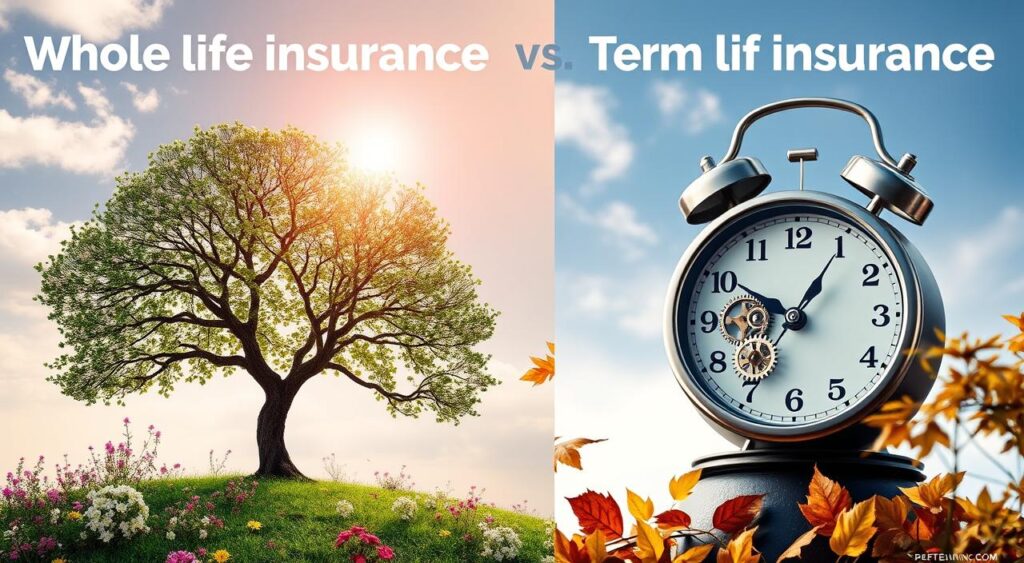Are you curious about whole life insurance? Many Americans find it hard to understand. They often think it costs way more than it does. But, with the right info, you can see how it offers lifelong protection and financial security.
Key Takeaways
- Whole life insurance covers you for life, unlike term life which has a time limit.
- It has a cash value part that grows tax-free, giving you more financial options.
- Premiums stay the same, no matter your health or age.
- You can use the cash value for loans or withdrawals, but it affects the death benefit.
- Whole life insurance can also give you dividends. You can use these to buy more coverage or lower your premiums.
What Is Whole Life Insurance?
Whole life insurance is a permanent life insurance that lasts your whole life. It’s different from term life insurance, which only lasts for a set time. Whole life policies have level premiums, meaning your payments stay the same.
Whole life insurance also has a cash value part. This part grows over time, tax-free. You can use this cash for loans or partial withdrawals. It adds flexibility and security to your finances.
| Feature | Whole Life Insurance | Term Life Insurance |
|---|---|---|
| Coverage Duration | Lifetime | Specific Period |
| Premium Structure | Level Premiums | Increasing Premiums |
| Cash Value | Yes | No |
Whole life insurance comes in two types: participating and non-participating. Participating policies might give dividends. These can buy more coverage or be cashed in. Non-participating policies don’t offer dividends.
Thinking about whole life insurance? Know its pros and cons. Compare it to term life insurance. Decide if it fits your needs and goals.
How Whole Life Insurance Works
Whole life insurance is a permanent type of life insurance. It guarantees a death benefit to the policyholder’s beneficiaries. This is in exchange for regular, level premium payments. The policy also has a cash value part, and policyholders can add more money to buy paid-up additions. These additions help grow the whole life insurance cash value over time.
The cash value in whole life insurance grows tax-free. Policyholders can borrow against it or cash it in for the accumulated value if needed. This cash value offers financial flexibility and security for the policyholder’s lifetime.
Guaranteed Death Benefit
Whole life insurance is known for its guaranteed whole life insurance death benefit. If the policyholder keeps paying premiums, the insurer will pay the full death benefit to the beneficiaries when the policyholder passes away. This gives financial protection and peace of mind to the policyholder’s loved ones.
Paid-Up Additions
Policyholders can make extra payments, called paid-up additions. These extra payments boost the policy’s cash value. This gives the policyholder more flexibility and a chance for a higher death benefit in the future.
Whole life insurance policies offer lifelong coverage. The premiums stay the same for the policyholder’s lifetime. This makes whole life insurance a great tool for long-term financial planning and building wealth.

Whole Life Insurance Cash Value
Whole life insurance has a special feature called cash value. It works like a retirement account. Every time you pay your premium, a part of it adds to the cash value. This value grows with tax-deferred interest, giving you a valuable fund for life.
The cash value in whole life insurance is very flexible. You can borrow against it, withdraw funds, or even cash out the policy. This can help with big expenses like college, a home down payment, or extra retirement money.
| Cash Value Accumulation | Tax-Deferred Growth | Flexible Access |
|---|---|---|
| A portion of each premium payment goes towards building the whole life insurance cash value. | The cash value grows on a tax-deferred basis, allowing for potentially higher returns over time. | You can access the whole life insurance cash value through loans, withdrawals, or policy surrender. |
Remember, using the cash value for loans or withdrawals will lower the death benefit for your heirs. Also, policy loans might have interest. Still, the cash value’s growth and flexibility make whole life insurance a great choice for many.

Whole Life Death Benefit
The death benefit of a whole life insurance policy is a key feature. It provides financial security for your loved ones. This tax-free death benefit is paid out in a lump sum to your beneficiaries when you pass away. The money is non-taxable to them, ensuring they get the full amount you wanted to protect them with.
However, some policy provisions can affect the death benefit amount. Unpaid loans or adding paid-up coverage can change the payout. It’s crucial to understand these factors. By reviewing your policy, you can make sure your death benefit meets your financial goals and protects your loved ones.
| Whole Life Insurance Death Benefit | Tax-Free Death Benefit |
|---|---|
| The death benefit of a whole life insurance policy is typically specified in the policy contract and is paid out to the designated beneficiaries in a lump sum upon the insured’s death. | The death benefit proceeds are generally non-taxable to the beneficiary, ensuring that your family receives the full amount you intended to protect them. |
It’s important to note that the death benefit can be impacted by various factors, such as:
- Unpaid loans on the policy
- The addition of paid-up coverage
By understanding these provisions and reviewing your policy, you can ensure that your whole life insurance death benefit aligns with your financial goals and provides the necessary protection for your loved ones.

“Whole life insurance is more expensive than term life insurance due to the guarantee of a death benefit; whole life policies assure policyholders of a death benefit, while term life policies provide coverage for a specific period.”
Uses of Whole Life Insurance
Whole life insurance gives families financial security when a breadwinner dies. It helps replace lost income, keeping loved ones financially stable. It can also boost retirement funds or protect a business from losing a key person.
For 38% of Americans, life insurance is key for passing on wealth. Whole life insurance helps build wealth for future generations. It also helps protect against estate taxes for 38% of Americans.
Whole life insurance offers lifelong coverage and grows in value over time. Policyholders can earn dividends, which have been paid by Northwestern Mutual since 1872. These dividends add to the policy’s value.
The cash value in whole life insurance can be used in several ways. It can be used for retirement, emergencies, or other financial needs. This flexibility is very helpful.
Riders can be added to whole life insurance for extra protection. These include benefits like waiver of premium or accelerated care. While they cost more, they offer tailored coverage.
In short, whole life insurance has many uses. It provides financial security for families and helps with estate planning. Understanding its uses helps individuals protect their loved ones and secure their financial future.
Types of Whole Life Insurance
Whole life insurance policies vary based on how you pay your premiums. There are several types:
- Level Payment Policies: Your premium stays the same for life.
- Single Premium Policies: You pay a one-time lump sum.
- Limited Payment Policies: You pay premiums for a set number of years. Then, the policy continues without more payments.
- Modified Whole Life Policies: You pay less in the beginning and more later on.
These policies can also be participating or non-participating. This depends on if you can get dividends.
| Type of Whole Life Insurance | Premium Payment Options | Key Features |
|---|---|---|
| Level Payment | Fixed, unchanging premiums | Lifelong coverage with guaranteed death benefit |
| Single Premium | One-time lump-sum payment | Immediate, fully-funded coverage |
| Limited Payment | Premiums paid for a set number of years | Lifelong coverage after premium period ends |
| Modified Whole Life | Lower premiums early, higher later | Flexible premium structure to suit changing needs |
These types of whole life insurance and premium payment options let you customize your coverage. You can match it to your financial situation and future plans.

Whole Life Insurance vs. Term Life Insurance
When looking at life insurance, you have two main choices: whole life and term life. Knowing the differences helps you pick the right policy for your needs and goals.
Whole life insurance covers you for life if you keep paying premiums. Term life insurance, however, only protects you for a set time, usually 10 to 30 years.
| Feature | Whole Life Insurance | Term Life Insurance |
|---|---|---|
| Coverage Length | Lifelong coverage | Coverage for a set period (10-30 years) |
| Premiums | Higher premiums | Lower premiums |
| Cash Value | Builds cash value over time | No cash value component |
| Complexity | More complex due to cash value feature | Simpler structure |
Term life insurance is cheaper and great for short-term needs like a mortgage or family support. Whole life insurance, however, offers lifelong coverage and can grow in value, making it better for long-term planning.
Choosing between whole life insurance and term life insurance depends on your needs, budget, and goals. For the best advice, talk to a licensed life insurance expert.

Advantages and Disadvantages of Whole Life Insurance
Whole life insurance covers you for your whole life if you keep paying premiums. It has good points but also some downsides to think about.
Advantages of Whole Life Insurance
- Lifetime Coverage: It covers you for life, no matter your health or age changes.
- Cash Value Accumulation: It grows a cash value over time. You can use this for loans or withdrawals.
- Guaranteed Death Benefit: It ensures a death benefit for your loved ones, giving them financial security.
- Predictable Premiums: Your premiums stay the same, making budgeting easier.
Disadvantages of Whole Life Insurance
- Higher Costs: It costs more than term life insurance, which might be hard for some to afford.
- Slower Cash Value Growth: Its cash value grows slower than other investments like stocks.
- Limited Flexibility: It has fixed benefits and premiums, making it hard to adjust as your needs change.
- Potential Impact of Loans or Withdrawals: Loans or withdrawals can lower the death benefit for your beneficiaries.
Choosing whole life insurance should be a careful decision. It depends on your financial goals, needs, and long-term plans.
Read More Another Content: How Much Is Insurance on a Car

how does a whole life insurance policy work
A whole life insurance policy offers coverage for your entire life. You pay a fixed amount of money regularly. This is different from term life insurance, which only covers you for a set number of years.
The money you pay in premiums helps fund the death benefit. The rest goes into building the policy’s cash value. This cash value grows tax-free, like a retirement account.
You can use the cash value for loans or withdrawals. But, this will lower the death benefit for your loved ones. The death benefit itself is always guaranteed, as long as you keep paying your premiums.
| Whole Life Insurance Key Features | Explanation |
|---|---|
| Lifetime Coverage | Whole life insurance provides coverage for the insured’s entire lifetime, unlike term life which has a specific coverage period. |
| Level Premiums | Premiums remain the same throughout the policy, unlike term life where they increase with age. |
| Cash Value Accumulation | A portion of each premium payment goes towards building the policy’s cash value, which earns tax-deferred interest. |
| Loan/Withdrawal Options | Policyholders can access the cash value through loans or withdrawals, though this reduces the death benefit. |
| Guaranteed Death Benefit | The death benefit is guaranteed to be paid out to beneficiaries upon the insured’s passing, as long as premiums are kept current. |
In summary, a whole life insurance policy offers lifelong coverage and the chance to build cash value. This gives you financial security and flexibility for your whole life.
What is the Cost of Whole Life Insurance?
Whole life insurance is pricier than term life insurance. For a healthy, nonsmoking 40-year-old man, a $500,000 whole life policy costs about $7,440 yearly. This is much more than the $334 yearly for a 20-year term life insurance premiums.
The higher whole life insurance costs come from its lifetime coverage and cash value. Also, there are commission fees. Smokers or those in poorer health will pay even more.
| Demographic | Whole Life Insurance Premium (Monthly) | Term Life Insurance Premium (Monthly) |
|---|---|---|
| 30-year-old Female Non-Smoker | $408 | $26 |
| 30-year-old Male Non-Smoker | $472 | $26 |
| 30-year-old Female Smoker | $505.20 | $26 |
| 30-year-old Male Smoker | $602.40 | $26 |
Remember, rates can change based on the coverage amount. Higher death benefits cost more. Also, women usually pay less than men because they live longer.
According to the Policygenius Life Insurance Price Index, life insurance rates remained steady in September 2024.
When looking at whole life insurance costs, consider many factors. These include age, health, gender, policy type, driving record, lifestyle, hobbies, criminal history, and credit history. All these can affect the premium costs.
Is Whole Life Insurance Worth It?
Deciding if whole life insurance is worth it can be tough. It gives you lifelong coverage and the chance to grow cash value. But, its higher costs compared to term life might not appeal to many.
It might be a good choice if you can afford the higher costs. This is true for high-income earners who have filled up other retirement accounts. Or, if you value the guaranteed cash value returns or are wealthy and want to help heirs with estate taxes. But, for most, term life insurance is cheaper and enough.
A healthy 40-year-old man might pay $7,440 a year for a $500,000 whole life policy. A woman of the same age could pay $6,512. On the other hand, term life insurance costs much less, at $334 for a man and $282 for a woman.
Whole life insurance has a cash value that can act as an emergency fund or for loans. But, this cash value grows slowly, with returns between 1% to 3.5% a year. It can take 10 to 15 years or more to have enough cash value to borrow against.
Whether to buy whole life insurance depends on your financial goals and needs. It’s crucial to weigh the costs, benefits, and downsides. Talking to a financial advisor can help you make a smart choice.
In short, whole life insurance might be a good choice for some, especially those with high incomes and complex financial situations. But, for most, term life insurance is likely a better and cheaper option.
How to Find the Right Whole Life Insurance Policy
When picking a whole life insurance policy, think about a few key things. This ensures you get the right coverage for your needs and financial goals.
Choose the Amount of Coverage You Need
First, figure out how much death benefit your family needs. Consider your income, debts, and how much financial security you want for your loved ones.
Examine Riders
Whole life insurance policies come with riders or add-ons. Look at riders for terminal illness, chronic illness, or disability. See if they match your protection needs.
Look at the Rate of Return on Cash Value
Whole life insurance builds cash value over time. This can be a valuable asset. Compare the cash value growth rates from different insurers to find the best one.
Be Aware of Surrender Charges
Most whole life insurance policies have surrender charges. These are fees if you cancel the policy early. Know these charges and how they decrease over time to avoid surprises.
Understand the Different Approval Processes
There are different ways to get whole life insurance. These include fully underwritten, simplified issue, and guaranteed issue. Each has its own rules and implications. Learn about them to choose the best one for you.
Compare Whole Life Insurance Quotes
Compare quotes from different insurers. This helps you find the best rates and coverage. It ensures you’re getting good value for your money.
Check the Insurer’s Financial Strength
Look at the financial strength of the insurers you’re considering. Choose ones with high ratings from agencies like A.M. Best. This shows they can pay claims reliably.
Research the Insurer’s Reputation for Customer Service
Also, check the insurer’s customer service reputation. Read reviews to see how they treat policyholders. This is important in your decision.
By thinking about these factors, you can find the right whole life insurance policy. It should match your coverage needs, financial goals, and protection priorities.
Conclusion
A whole life insurance policy offers lifelong coverage and a growing cash value. This provides financial security and extra income for both policyholders and their heirs. It’s more costly than term life but might suit high-income earners, those seeking guaranteed returns, or those with estate planning needs.
Choosing the right whole life policy involves looking at several key factors. These include the coverage amount, available riders, cash value growth, and surrender charges. Also, the insurer’s financial strength and customer service reputation are important. The whole life insurance summary and key takeaways highlight the need to carefully evaluate these aspects to ensure the policy fits your long-term goals.
In summary, a whole life insurance policy can be a wise investment. It offers lifelong coverage and the chance for extra income through the cash value. By understanding whole life insurance well and evaluating your options carefully, you can make a choice that supports your financial health and protects your loved ones.
FAQ
How does a whole life insurance policy work?
A whole life insurance policy covers you for life. You pay a fixed amount each month. A part of this goes into a cash value that grows without taxes.
You can use the cash value for loans or withdrawals. But, this will lower the death benefit. The death benefit is guaranteed to your loved ones if you keep up with payments.
What is whole life insurance?
Whole life insurance covers you for life. It also grows a cash value that’s tax-free. The monthly payments stay the same throughout.
What is the difference between whole life insurance and term life insurance?
Whole life insurance covers you forever. Term life insurance only covers you for a set time, like 10 or 20 years. Whole life also has a cash value that grows, but it costs more.
How does the cash value in a whole life insurance policy work?
The cash value in whole life insurance grows like a retirement account. It’s tax-free. You can use it for loans or withdrawals during your life.
How is the death benefit in a whole life insurance policy paid out?
The death benefit is paid out to your beneficiaries when you pass away. It’s usually a lump sum. The money is tax-free to them. But, loans or changes to the policy can affect the amount.
What are the main uses of whole life insurance?
Whole life insurance provides financial security for your family. It can replace your income if you pass away. It can also help with retirement or protect your business.
What are the different types of whole life insurance?
There are several types of whole life insurance. They differ in how you pay premiums. You can choose from level payments, single payments, or limited payments. Some policies offer dividends, while others don’t.
What are the advantages and disadvantages of whole life insurance?
Whole life insurance offers lifetime coverage and a cash value. It also has a guaranteed death benefit and fixed payments. But, it’s more expensive than term life and has limited flexibility.
How much does whole life insurance cost?
Whole life insurance is pricier than term life. A $500,000 policy for a 40-year-old might cost $7,440 a year. Term life for the same amount is about $334 a year.
Is whole life insurance worth it?
Whole life insurance might be right for you if you can afford it. It’s good for those with high incomes or looking for guaranteed returns. But, for most, term life is cheaper and enough.
How do I find the right whole life insurance policy?
To find the right policy, consider your needs and the coverage amount. Look at riders and the cash value’s return. Be aware of surrender charges and the approval process. Compare quotes and check the insurer’s financial strength and reputation.

